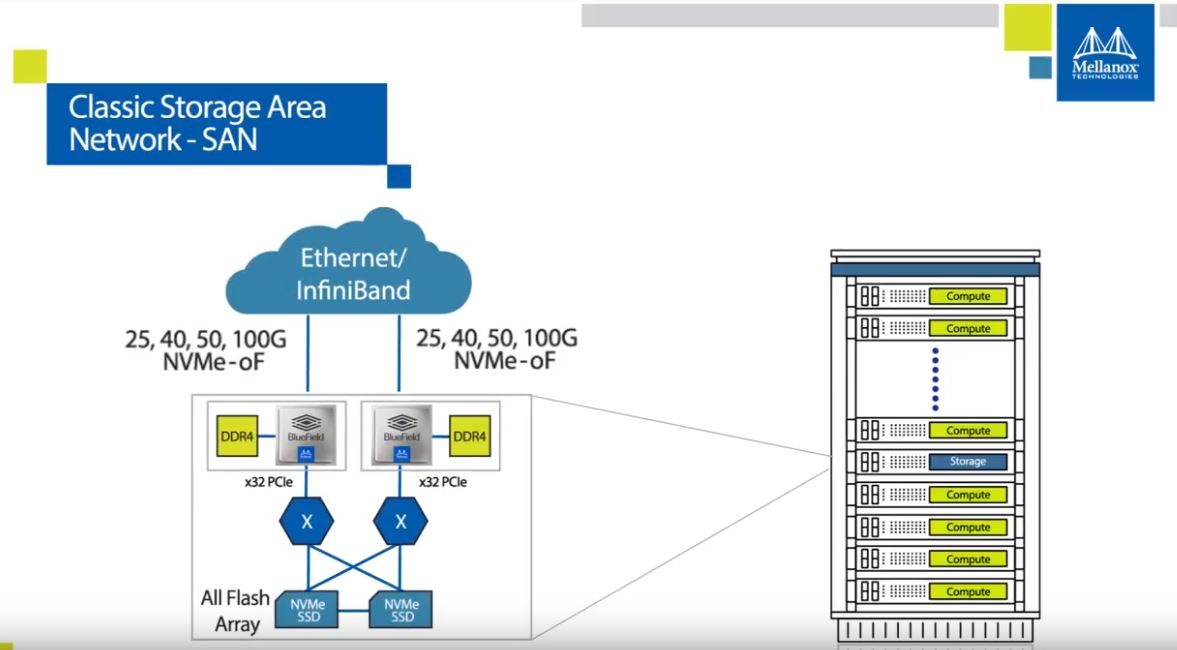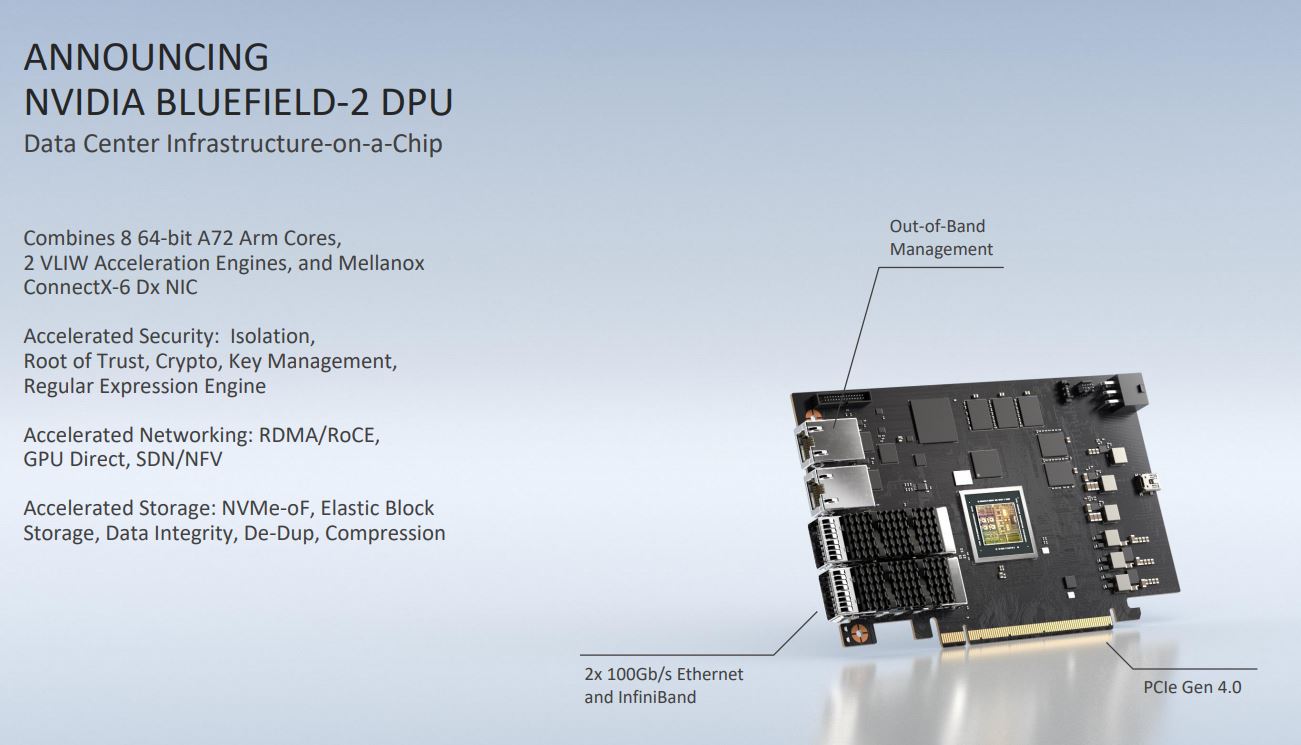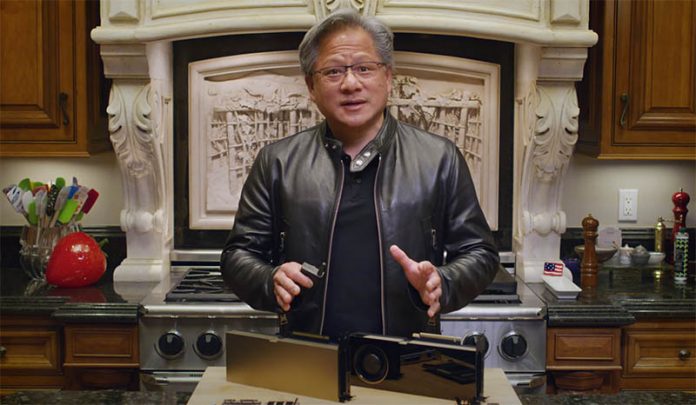This week as part of the GTC 2020 (#2) festivities as well as Arm DevCon, I was able to ask Jensen Huang, CEO of NVIDIA about a question lingering about the company’s data center strategy: storage. NVIDIA has the leadership GPU position, as well as in AI acceleration with its hardware and CUDA software stack. NVIDIA also purchased networking stacks with the acquisitions of Mellanox and Cumulus. With Arm, NVIDIA will have a data center CPU story. Since NVIDIA has a great story around processing and moving data, the logical question is what about storing that data.
The NVIDIA Data Center Storage Plan
On a call this week, I asked Jensen about the conspicuous storage hole in the NVIDIA lineup. Specifically, in light of the company’s BlueField-2 DPU product (see here for “What is a DPU?“) For those who have not been following the genesis of BlueField, when we first covered it in 2017 (see Mellanox BlueField NVMeoF SoC Solution) it was primarily being positioned as a storage solution. As an example, see how the BlueField (1) was being positioned for the classic SAN in 2018:

While NVMeoF is still an emerging space in enterprise data centers, many of the large infrastructure shops already have a solution in the space. Indeed, during an Arm DevCon infrastructure panel, led by Chris Bergey’s team, we heard various cloud providers discuss NVMeoF transitions in the past tense. BlueField-2 has those accelerators built-in, along with some of the surrounding capabilities such as RoCE. In essence, NVIDIA already has the foundational building block to deliver an Arm-based storage NVMeoF or storage node solution with its DPUs. So the question I posed was simply whether NVIDIA plans to tackle that space.

Jensen gave a very unambiguous answer to my question. That was not the plan for NVIDIA. His view was that NVIDIA should engage in the solutions where there is an unmet market need. Storage is one of those areas where he feels that the current ecosystem is doing well. As such, that is not an area that NVIDIA needs to compete directly in.
What Jensen also made clear, is that NVIDIA is looking to enable an ecosystem on the storage side as well. Jensen left the door open to products like the BlueField-2 being used by storage solution vendors. Some context here is that a lot of storage vendors either already have Arm cores in storage or are including more Arm cores in their future solutions. Effectively, NVIDIA seems content to sell its portfolio into the storage ecosystem but is not looking to go into direct competition in the storage space at this point.
From a business perspective, this makes a lot of sense. NVIDIA tends not to compete in markets where it cannot lead, and the path to creating a leading storage solution is a long one.
Final Words
Silicon Valley is littered with failed storage startups and storage products from big companies that never proved a commercial success. In some ways, it is like the old telecom model where validation cycles are long which means there is a long time between when a product is released and when revenue can be recognized. A new storage solution takes time to gain customer trust. At this point, there are a lot of solutions out there for storage and NVIDIA does not see that as a market to disrupt.
For NVIDIA, it is also important to demonstrate that it is continuing to help increase competition in the data center by providing enabling technologies rather than usurping every aspect of data center infrastructure from its partners. What is clear is that NVIDIA is positioning itself as an enabling technologies partner for the storage system, rather than try to take on that market. Jensen’s message was received loud and clear.




This probably also stems from the fact that nVidia is at its core a hardware company and to do anything interesting in storage these days is really a software play. Aside from 3d xpoint, all the interesting storage stuff happening is from developers coding secret sauce to manage a pool of drives. All the hardware changes happening are established paradigms in predictable evolutions like moving to PCIe 4, ethernet speed upgrades, or different physical layouts to pack more spinning rust into a given volume. None of those is a game changer that a new entrant can develop and break into the market with.
I’d been pondering this too.
The software side of storage has indeed been the more exciting thing the past few years. NVMe in many respects is a software upgrade over the SATA Express standard that never had drives ship for it. 3D xpoint is exciting but more so from the software side of it. The system software dynamic changes if there is no addressable DRAM, only 3D xpoint and various levels of coherent caching. I see that level of software change well over 5 years out but if you think about it, at that point the storage layer of software disappears as everything in your file system becomes directly accessible as memory.
I would argue that there is room for some interesting hardware changes to storage that could happen. Seagate for example toyed with the idea of directly attaching storage to the network via Ethernet. Combine that with NVMEoF or RoCE and you now that storage that can scale up with the speed of your network. Though to your earlier point, how a networked cluster of drives is managed and partitioned in such an environment is just as important as the change the underlaying hardware. This is fine as a commercial experiment at this juncture. If the market matures and adopts it, nVidia could also acquire a smaller player/startup in this segment.
I do think the concept of the DPU will ultimately be short lived as systems are able to be designed to leverage greater chiplet based designs. nVidia already has a research paper describing a multi-chip module approach to a GPU. What is stopping form expanding that concept to include a chiplet with server class ARM cores and another die for fabric? DPUs are about removing some of the latency in the system between the host processor performing operations and the peripherals sending then the requisite data. PCIe 5.0 and CLX are on the horizon to help further reduce latencies too where chiplets need even more via external communication. The niche the DPU fits well today is going evaporate tomorrow.
Am I the only one to notice that Jensen has WAY too many scrapers in that kitchen
I can sell Leica / Hasselblad branded “party album” zeros conf social and family event dumps for later review. Zip up nips, smooth harsh flash closeups, that’s a concierge assist and privacy enforcer and fast enough that the fastest cards the host gave to everyone on arrival are the only bottleneck and people are studying the combo data and battery equipment with intention.
That’s crazy placement in social media houses etc and WAG-ungs (usually nice generally silly) meets ie 24 /7
Many movie film archive jobs are set and forget.
Make BMDs scanners auto loads and load stacks of reels sequentially and you’ll be filling up 12 but 12K RAW minimum per frame
N.B. all my suggestions are Surface / Reference Design territory m
You’d expect to see maybe even Kodak restored in name at least.
Remember those yellow concrete feet where you stand holdings your camera F8 AND BE THERE?
Actually let me pay nvidia to supply me with top notch ODM hardware for Packington GPU into and I’ll fill her up with 10*100*18TB radial rust rings please!
Let me custom hardly ever more than a couple things FIX MY QUOTE STABLE SO I CAN BUY FOR SMALL BUSINESSES AND I’M YOURS!
Cosmetics too please but matching your green goo
Host buyer workshops and donate your best thermal and plastics people to whichever settles out the winner design. Sure let customers compete for priority and features etc. Probably that’ll create instant consortia
MAKE visiting NVIDIA A FULL COMBAT SUPPLY CERTAINTY
FMJ
60 POUND PACK
YOMP ROMP
Round up every military acronym meaning GO PILL
Get xbox to add a branded memory vault somehow and you won’t hear from Sony way any barracks.
High value photos hosting will sell 2 billion 80 inch and larger screen to America and Europe alone. Really double glazing shutters. I totally would now.
I guess I haven’t been any way subtle today. I simply see they open fields of deck billions literally all around them.
Tune up the green to darker Hqrrods green and you very entered a business where few people know Harrods Bank was the most highly recommended for bring regular guys considering they’re a private bank afternoon all but totally decent straight talking humans which very high end products like the Aston F1 sim crate absolutely do require the highest level of handholding and storage PERSONAL FILES FOR CRIPES SALE ARE BEGGING A SECURITY SOLUTIONS…
Enforce multiple secret simultaneously required keys and baseline storage quintiples at commodity levels and triples at super premium level.
DOh BUT THE HAVE TO BUY A DRIVE MAKER OR FORGET THE IDEA WHOLESALE
I totally will buy shingle 100 tb drives on 25gbe with ARM collapsed spine composing processing that can do vectors.
I’ll bury it in a heat pump pit and run family projects thru the winter and get my neighbourhoods newspaper archive finally digitized.
Like giving people the Tesla power unit, give people a serious unit of stowage. (Leaving that typo hmm) and plenty will happen.
Digital archives have forever had human ingest restraints.
That’s a gone bottleneck soon. Only hasten the day.
Put 4 friends of mine along the same garden path out back and we’ll fill tens of petabytes with out of copyright books ASAP.
Hope not but it might pay to be the green light of hope people are unearthing in a future devastation.
At least go with movie product placement already!
Just one moment please in the retail and BOHO BELOW SME ABOVE SOHO procurement universe where humans don’t ever come with a any actual hardware unless you’re a rockstar and also a prop too…
40 percent is the premium I’m convinced that nvidia can market up every kind of storage competent SKU forever as long as you keep stock and print annual major catalogues and permit check payment on Pro Format and honor thy warranties do help thee God.
Literally every possible thing from u160 termination block to a tray of 200 Optane 5 12.
Stick green QA cert receipts and take my money.
NVIDIA partners across the storage ecosystem, particularly with NetApp. If they were to make a play, it would be an acquisition of a vendor with a strong customer base (existing cash flow plus new customer acquisition).